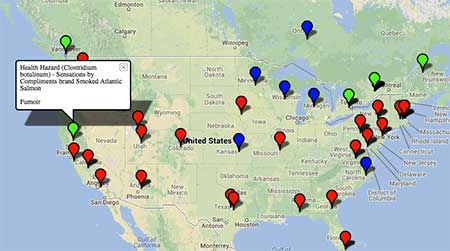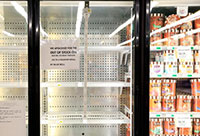Ensuring Compliance to Avoid a Food Recall
As a consumer, news of food recalls is often alarming, raising concerns about the possibility of consuming potentially contaminated and harmful products. For manufacturers, a food safety recall signals a shortfall in internal quality control processes. It also represents significant and often avoidable expenses that can harm a manufacturer’s financial health, and garner negative media attention, which can be difficult to overcome, and take years to restore lost client goodwill. To ensure that your company is compliant, the following is a quick and easy guide to the criteria that may trigger a food recall in Canada.
Before the Recall: Food Safety Investigations
 Food safety investigations are complex and several steps are needed to determine if a food recall is required. Investigations are carried out by a variety of experts at Canadian Food Inspection Agency (CFIA). When conducting an investigation, CFIA has three primary objectives:
Food safety investigations are complex and several steps are needed to determine if a food recall is required. Investigations are carried out by a variety of experts at Canadian Food Inspection Agency (CFIA). When conducting an investigation, CFIA has three primary objectives:
1. Determine which foods could be unsafe;
2. Track the locales where potentially harmful products have been distributed; and
3. Determine the root cause of the problem.
Several things can trigger a food safety investigation and could lead to a food recall:
1. Outbreak of Illness: Public health officials identify a potential link between an illness and a specific food.
2. Food test results: Results obtained by CFIA, the food industry, a provincial or territorial government or another country can identify a possible health risk.
3. CFIA inspection finding: Certain activities (such as visual observation of products and manufacturing practices or analysis of company records) can detect a food safety concern.
4. Consumer complaint: A complaint about the safety of a food product is received by CFIA.
5. Recall in another country: Another country recalls a food product that is also sold in your country.
6. Other triggers: They may include information from law enforcement about potential food tampering, trade complaints, information from consumer associations, or even posts on social media websites.
Alternatively, a company may undertake a self-initiated recall and subsequently inform CFIA of its actions.
High-, Medium- or Low-Risk Recalls
 If a potential health risk is identified during a food safety investigation, CFIA will request a health risk assessment (HRA) from Health Canada. The purpose of this assessment is to determine what level of risk a specific food poses to the Canadian population. Based on the HRA, CFIA will determine the most appropriate action, including whether or not to recall a product. If a recall is necessary, CFIA will decide whether the recall should be Class I (high risk), Class II (moderate risk) or Class III (low and no risk) recall.
If a potential health risk is identified during a food safety investigation, CFIA will request a health risk assessment (HRA) from Health Canada. The purpose of this assessment is to determine what level of risk a specific food poses to the Canadian population. Based on the HRA, CFIA will determine the most appropriate action, including whether or not to recall a product. If a recall is necessary, CFIA will decide whether the recall should be Class I (high risk), Class II (moderate risk) or Class III (low and no risk) recall.
Initiating a Voluntary Recall
Following Health Canada’s assessment, CFIA may ask that request the company to initiate a voluntary recall. At this time, a number of things can happen:
1. Recall Implementation
The company must immediately contact all of the distributors or retailers that received the recalled product. This requires up-to-date and well-kept distribution records to ensure a quick response time on the part of the company.
2. Informing the Public
In the event of a high-risk recall, consumers must be informed immediately, so that they can collect and dispose of any product they may have in their homes. In some instances, the CFIA will issue an alert to the media, make information available on its website, and/or provide information via its email distribution list, Twitter, RSS feeds, and other mobile apps.
3. Recall Verification
Once the manufacturer has indicated that the recalled food has been removed from the market, the CFIA will conduct an effectiveness check to verify that any and all unsafe food has been removed from store shelves.
4. Follow-up
For some time following the recall, CFIA may heighten oversight and testing for a defined period of time, and review the company’s standards and policies or work with the company that initiated the recall to resolve any shortcomings or oversights in its quality-control system that initially led to a product recall.
Conclusion
Even though recalls can be extremely costly, they are one of the most practical mechanisms through which governments can ensure food products are safe for consumption. Companies should be mindful of re-evaluating their quality-control programs frequently. This will ensure that both their processes and their employees are producing the safest and most sanitary food products for consumption. Otherwise, they may face the daunting task of initiating a recall and corrective action imposed by the CFIA.
It is important to keep in mind that not all recalls are reported to the public. Nevertheless, information on recalls is publicly available on CFIA’s website under the “Food Recalls and allergy allerts” section. The availability of this information may be an important consideration when assessing the release of borderline-compliant products.
About the Author
Cristelle Gedeon Ph.D is an associate in the Toronto offices of Fasken & Martineau and is a member of the Ontario Region Life Sciences Group specializing in regulatory affairs and intellectual property.
To have more articles like this emailed to your inbox, become a GFSR Member today!

